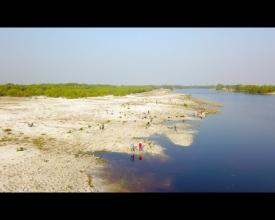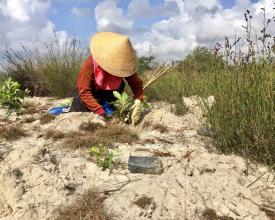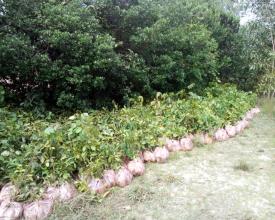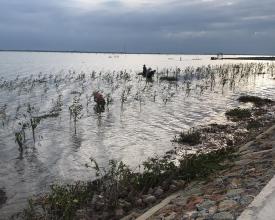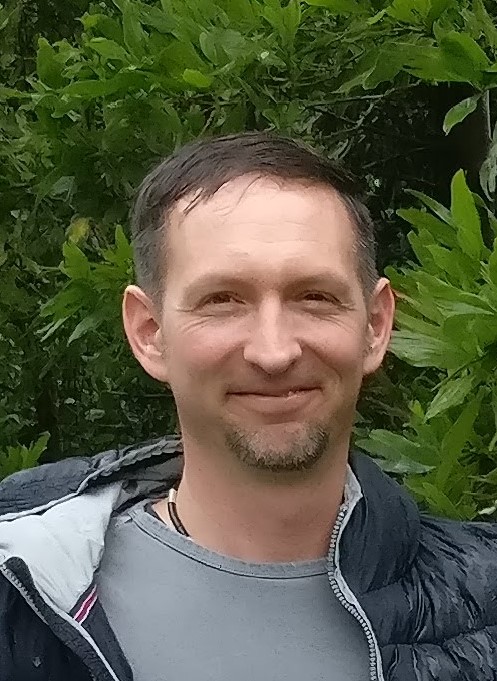
Coastal Forest Restoration (CFR) in Vietnam
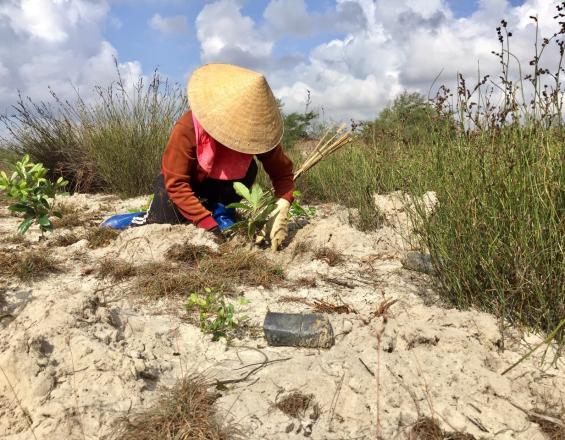
Vietnam is highly vulnerable to climate change. Typhoons often make landfall in the country, with massive negative impacts on humans and the economy. Intact and highly biodiverse coastal forests have essential protective functions and mitigate the effects of tropical storms. The IKI project "Ecosystem-based Adaptation in the North Central Coast of Vietnam: Restoration and Co-management of Degraded Dunes and Mangroves" is the first significant effort to restore degraded coastal protection forests on dunes and sandy areas. The project is implemented by unique land use GmbH and the Institute of Resources and Environment (IREN) since 2018. The team has developed and piloted an innovative restoration approach. It uses exclusively native tree species, partly critically endangered IUCN red list species. The planting design mimics the naturally occurring species composition and growth patterns as found in natural forest remnants in the project provinces. The primary beneficiaries are the local partner communities.
Context
Challenges addressed
Once the vegetation and forest cover have been removed from the vulnerable dunes it is technically very challenging to restore the sandy areas (long draughts, surface temperatures above 60° C, inundation and floods, fire, extremely poor nutrients, high salination levels etc.). Land use pressure for aquaculture, tourism or sand mining is high - especially when the land is perceived as not beneficial it will be abandoned or converted. restoration secures and provides tangible benefits to the local land owners.
Seedling identification and nursery practices require significant scientific knowledge. The native tree species are better adapted than often planted non-native species like Casurina or Acacia spec. Farmers lack this knowledge and need support in planting, treatment and NTFP options.
Location
Process
Summary of the process
Sound planing, implementing FPIC and consultations with all relevant stakeholders are prerequisites for local ownership.
For the design, entry points and inclusion of local and traditional knowledge is very important to secure the long-term-acceptance and to tap the benefits for the local people. At the same time, scientific knowledge about tree species, nursing techniques and soil improvement are crucial to maintain the interest and excitement of the local people ... so it is not perceived as a project but rather as a story that optimally replicates itself when the support ends. M+E is needed to check the assumptions and refine and improve the solution.
Building Blocks
Local ownership and co-management
The project follows a co-management approach from the outset - partner communities and local authorities have been consulted prior to planning and implementation. They have been actively involved in all steps of the project implementation, received training and were compensated for their efforts (planting). Examples include the integration of their local knowledge about the selected species and the benefits such as NTFPs.
Enabling factors
Key is a good understanding of the local stakeholders and farmers to not only understand the purpose but also the benefits they will have if the project is implemented successfully. This goes beyond the planting and includes the management, to secure success beyond the project's lifetime. With a view to upscaling itis also crucial to align with local and national policy priorities and support the backing of decision-makers. Lastly, dissemination to receive braoder support.
Lesson learned
It is difficult but can and has to be done - the ecosystem services are vital to the local population and the intensity of storms and droughts requires action and upscaling. Errors in this pilot work are necessary to improve the approach because there is little knowledge about the selected species, some of which are threatened by extinction (e.g. Shorea falcata). We have learned many lessons, e.g. on how to improve the seedling quality in the nursery and the planting approach, which are two crucial factors for the survival rates.
Technical knowledge on sites, species and nurseries
The sites are heterogeneous and have different degrees of degradation, resulting in different intervention needs and opportunities. It is crucial to understand which species appear in nature as groups and to design the planting design accordingly. Mother trees, flowering periods and storability of seeds need to be known and the planting has to be adapted according to suitable planting periods. In the nursery, the focus on good root systems of the seedlings is key, requiring appropriate nursing equipment, substrate and trained staff.
Enabling factors
- knowledge, link to research and traditional knowledge
- capacities to collect seed material from the right tree for the right place and the right purpose
- sufficient funding and training capacities
Lesson learned
Investment of time and funding in the above-named factors pays off in form of higher survival rates, better growth, and project success. Some aspects should not be compromised, for example the size of the seedling containers and the substrate.
Monitoring + Evaluation
Given the lack of experience and the high need for learning and improving the solution, M+E is key. Starting in the nursery how the different seedlings develop, then after planting and in regular intervals. this allows improving the design, to determine the need for soil improvement, suitability of individual species on respective sites and many other aspects - including upscaling to other areas and countries with similar needs and circumstances.
Enabling factors
- Capable institutions and link / partnerships to scientific organizations and individuals
- Local ownership and dedication, also beyond the project's lifetime
- a sound and realistic monitoring system from the outset
Lesson learned
M+E needs to focus and should be carried out by knowledgeable and dedicated individuals and organizations. It should also involve the local landowners and their traditional knowledge
Impacts
Restoring highly degraded coastal areas classified as protection forests provides multiple benefits for the local farmers and fishermen who own the land, as well as for biodiversity conservation. The dunes and sandy areas reach from the shoreline up to 10 km inland. Marked by extreme climatic conditions the farmers living in this area need the dunes and forest cover as windshield, and as water resource for their subsistence agriculture.
Many of the selected native / endemic tree species provide additional income through NTFPs, e.g. as essential oils, edible oils or medicinal plants. They are important habitats for migratory birds, insects as dragon flies and many other, partially critically endangered species of flora and fauna.
Beneficiaries
The main beneficiaries are the local farmers, fischermen and the rural population. Secondary beneficiaries are policymakers and scientific institutions involved in rehabilitating and restoring forest landscapes.
Sustainable Development Goals
Story
Directly after finalizing the planting of 600,000 seedlings on 500 ha, the project region was struck by a series of typhoons in October 2020. The initially very high survival rates of 80+% after 3 months were drastically reduced, depending on the level of affection and duration of the flood (to 10 to 40%). However, some species showed a strong ability to resprout, demonstrating the high suitability of the native tree species and confirming both - the need for EbA and restoration, as well as the developed approach. Building on the many lessons learned the team is currently improving the approach and the seedling quality - in a model nursery and replanting. In addition, the model is promoted to mobilize additional funding for upscaling.

